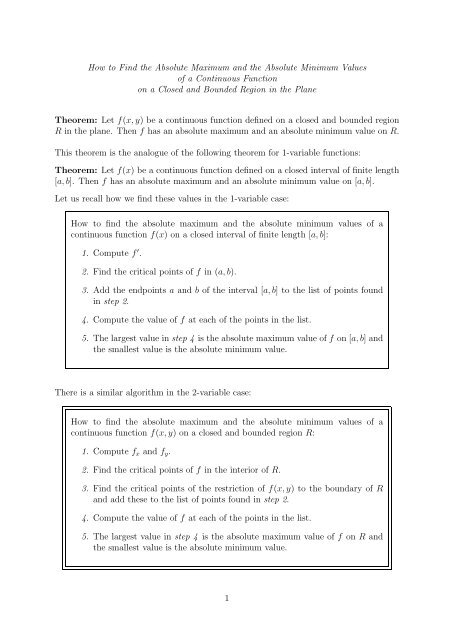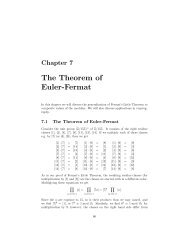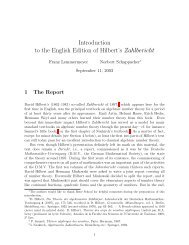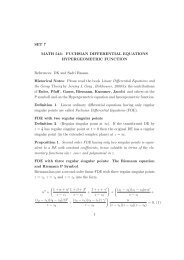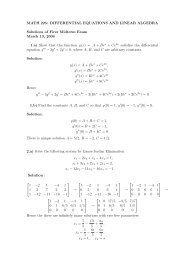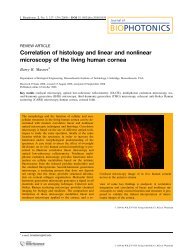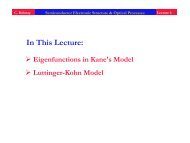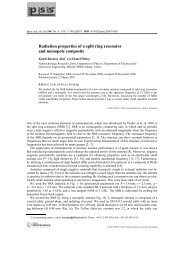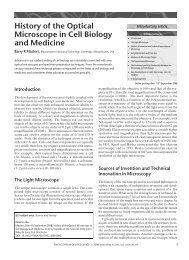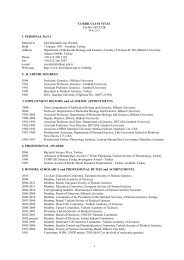How to Find the Absolute Maximum and the Absolute Minimum ...
How to Find the Absolute Maximum and the Absolute Minimum ...
How to Find the Absolute Maximum and the Absolute Minimum ...
Create successful ePaper yourself
Turn your PDF publications into a flip-book with our unique Google optimized e-Paper software.
<strong>How</strong> <strong>to</strong> <strong>Find</strong> <strong>the</strong> <strong>Absolute</strong> <strong>Maximum</strong> <strong>and</strong> <strong>the</strong> <strong>Absolute</strong> <strong>Minimum</strong> Values<br />
of a Continuous Function<br />
on a Closed <strong>and</strong> Bounded Region in <strong>the</strong> Plane<br />
Theorem: Let f(x, y) be a continuous function defined on a closed <strong>and</strong> bounded region<br />
R in <strong>the</strong> plane. Then f has an absolute maximum <strong>and</strong> an absolute minimum value on R.<br />
This <strong>the</strong>orem is <strong>the</strong> analogue of <strong>the</strong> following <strong>the</strong>orem for 1-variable functions:<br />
Theorem: Let f(x) be a continuous function defined on a closed interval of finite length<br />
[a, b]. Then f has an absolute maximum <strong>and</strong> an absolute minimum value on [a, b].<br />
Let us recall how we find <strong>the</strong>se values in <strong>the</strong> 1-variable case:<br />
<strong>How</strong> <strong>to</strong> find <strong>the</strong> absolute maximum <strong>and</strong> <strong>the</strong> absolute minimum values of a<br />
continuous function f(x) on a closed interval of finite length [a, b]:<br />
1. Compute f ′ .<br />
2. <strong>Find</strong> <strong>the</strong> critical points of f in (a, b).<br />
3. Add <strong>the</strong> endpoints a <strong>and</strong> b of <strong>the</strong> interval [a, b] <strong>to</strong> <strong>the</strong> list of points found<br />
in step 2.<br />
4. Compute <strong>the</strong> value of f at each of <strong>the</strong> points in <strong>the</strong> list.<br />
5. The largest value in step 4 is <strong>the</strong> absolute maximum value of f on [a, b] <strong>and</strong><br />
<strong>the</strong> smallest value is <strong>the</strong> absolute minimum value.<br />
There is a similar algorithm in <strong>the</strong> 2-variable case:<br />
<strong>How</strong> <strong>to</strong> find <strong>the</strong> absolute maximum <strong>and</strong> <strong>the</strong> absolute minimum values of a<br />
continuous function f(x, y) on a closed <strong>and</strong> bounded region R:<br />
1. Compute fx <strong>and</strong> fy.<br />
2. <strong>Find</strong> <strong>the</strong> critical points of f in <strong>the</strong> interior of R.<br />
3. <strong>Find</strong> <strong>the</strong> critical points of <strong>the</strong> restriction of f(x, y) <strong>to</strong> <strong>the</strong> boundary of R<br />
<strong>and</strong> add <strong>the</strong>se <strong>to</strong> <strong>the</strong> list of points found in step 2.<br />
4. Compute <strong>the</strong> value of f at each of <strong>the</strong> points in <strong>the</strong> list.<br />
5. The largest value in step 4 is <strong>the</strong> absolute maximum value of f on R <strong>and</strong><br />
<strong>the</strong> smallest value is <strong>the</strong> absolute minimum value.<br />
1
Example: <strong>Find</strong> <strong>the</strong> <strong>the</strong> absolute maximum <strong>and</strong> <strong>the</strong> absolute minimum values of f(x, y) =<br />
x 3 − xy + y 2 − x on R = {(x, y) : x ≥ 0, y ≥ 0 <strong>and</strong> x + y ≤ 2}.<br />
We apply <strong>the</strong> algorithm:<br />
1. fx = 3x 2 − y − 1 <strong>and</strong> fy = −x + 2y.<br />
2. We have <strong>to</strong> solve <strong>the</strong> equations 3x 2 − y − 1 = 0 <strong>and</strong> −x + 2y = 0 simultaneously.<br />
From <strong>the</strong> second one we solve for x <strong>to</strong> get x = 2y <strong>and</strong> substitute it in <strong>the</strong> first one<br />
<strong>to</strong> get 3 · (2y) 2 − y − 1 = 0 =⇒ 12y 2 − y − 1 = 0 =⇒ y = 1/3 or y = −1/4 . Since<br />
x = 2y, <strong>the</strong>se give <strong>the</strong> x-values y = 1/3 =⇒ x = 2/3 <strong>and</strong> y = −1/4 =⇒ x = −1/2.<br />
So we obtain <strong>the</strong> points (x, y) = (2/3, 1/3) <strong>and</strong> (x, y) = (−1/2, −1/4). Note that<br />
<strong>the</strong> second point is not in R. So we put only <strong>the</strong> first one, (2/3, 1/3) in our list.<br />
This is important! If you include points that are not in R in your list, <strong>the</strong>re is no<br />
guarantee that <strong>the</strong> algorithm will give <strong>the</strong> correct answer.<br />
3. Now we come <strong>to</strong> <strong>the</strong> boundary. The boundary of R is <strong>the</strong> union of three sides of <strong>the</strong><br />
triangle: Side I = {(x, y) : 0 ≤ x ≤ 2 <strong>and</strong> y = 0}, Side II = {(x, y) : x = 0 <strong>and</strong> 0 ≤<br />
y ≤ 2} <strong>and</strong> Side III = {(x, y) : x + y = 2 <strong>and</strong> 0 ≤ x ≤ 2}. So we have essentially<br />
three 1-variable problems <strong>to</strong> solve:<br />
Side I : We parametrize this side in <strong>the</strong> obvious way: x = t, y = 0 for 0 ≤ t ≤ 2.<br />
Then <strong>the</strong> restrictions of f <strong>to</strong> Side I is f(t, 0) = t 3 · 0 − t · 0 − 0 2 − t = t 3 − t for<br />
0 ≤ t ≤ 2. Now we find <strong>the</strong> list of points for this 1-variable optimization problem:<br />
d/dt(f(t, 0)) = 3t 2 − 1 = 0 =⇒ t = 1/ √ 3 or t = −1 √ 3 . The second solution is not<br />
in <strong>the</strong> interval [0, 2], so we only take <strong>the</strong> first one t = 1/ √ 3, <strong>and</strong> <strong>the</strong> endpoints of <strong>the</strong><br />
interval [0, 2], t = 0 <strong>and</strong> t = 2. These correspond <strong>to</strong> <strong>the</strong> points (x, y) = (1/ √ 3, 0),<br />
(x, y) = (0, 0), <strong>and</strong> (x, y) = (2, 0).<br />
Side II : This is similar <strong>to</strong> <strong>the</strong> previous calculation: f(0, t) = t 2 for 0 ≤ t ≤ 2.<br />
d/dt(f(0, t)) = 2t = 0 =⇒ t = 0. This is one of <strong>the</strong> endpoints, <strong>the</strong> o<strong>the</strong>r one is<br />
t = 2, <strong>and</strong> <strong>the</strong>y correspond <strong>to</strong> <strong>the</strong> points (x, y) = (0, 0) <strong>and</strong> (x, y) = (0, 2) in <strong>the</strong><br />
plane.<br />
Side III : This time one possible parametrization is x = t, y = 2 − t for 0 ≤ t ≤ 2.<br />
This gives f(t, 2 −t) = t 3 +2t 2 −7t+4 for 0 ≤ t ≤ 2. Then d/dt(f(t, 2 −t)) = 3t 2 +<br />
4t − 7 = 0 =⇒ t = 1 or t = −7/3. Again <strong>the</strong> second solution is not in <strong>the</strong> interval<br />
we are looking at. The first one gives t = 1 =⇒ (x, y) = (t, 2 − t) = (1, 1). So our<br />
points, including <strong>the</strong> endpoints, are (x, y) = (1, 1), (x, y) = (2, 0) <strong>and</strong> (x, y) = (0, 2).<br />
To summarize, we found <strong>the</strong> points<br />
(0, 0), (2, 0), (0, 2), (1/ √ 3, 0), (1, 1)<br />
in this step. So now <strong>the</strong> complete list of points we are going <strong>to</strong> look at is<br />
(2/3, 1/3), (1/ √ 3, 0), (0, 0), (2, 0), (0, 2), (1, 1) .<br />
2
4. The values at <strong>the</strong>se points are:<br />
f(2/3, 1/3) = − 13<br />
27<br />
f(1/ √ 3, 0) = − 2<br />
3 √ 3<br />
f(0, 0) = 0 f(0, 2) = 4<br />
f(2, 0) = 6 f(1, 1) = 0<br />
5. Among <strong>the</strong>se values, −13/27 is <strong>the</strong> smallest <strong>and</strong> 6 is <strong>the</strong> largest. Therefore, <strong>the</strong><br />
absolute maximum value of f on R is 6, <strong>and</strong> it occurs at <strong>the</strong> point (x, y) = (2, 0); <strong>and</strong><br />
<strong>the</strong> absolute minimum value is −13/27 <strong>and</strong> it occurs at <strong>the</strong> point (x, y) = (2/3, 1/3).<br />
y<br />
(0, 2)<br />
0<br />
Side II<br />
R<br />
4<br />
−13/27<br />
(1, 1)<br />
(2/3, 1/3)<br />
Side III<br />
(0, 0) (1/ Side I<br />
√ 3, 0) (2, 0)<br />
3<br />
0<br />
−2/(3 √ 3)<br />
6<br />
x


